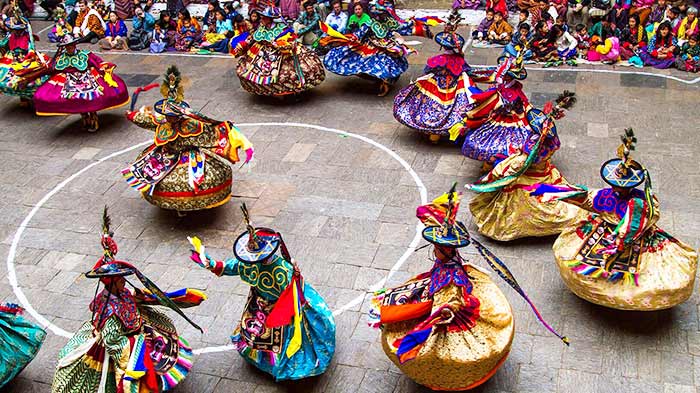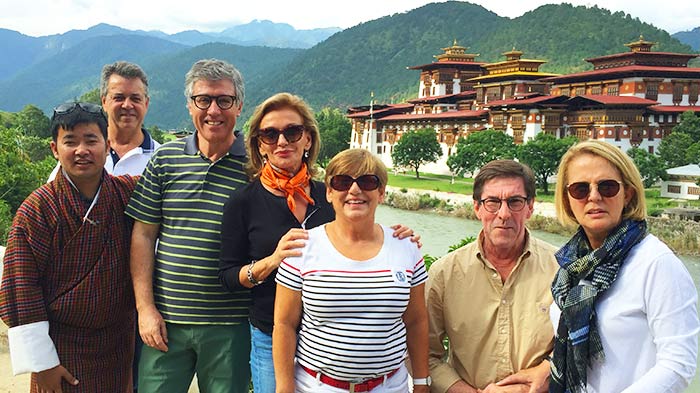
Top Bhutan Holiday and Travel Tips
The last great Shangri-La, and a land shrouded in myth and mystery, the Kingdom of Bhutan is a country where traditional culture and modern development lie side by side. Touring Bhutan when exotic traditional Bhutanese festivals are held would be your best choice for cultural explorers.
Bhutanese Holidays and Festivals
Bhutan has dozens of festivals throughout the year, with majority in the spring and fall. Most of the time these festivals can last for three to four days, and they are an experience you will not want to miss. Plan your trip around one of the festivals in the time period you are planning to go, and you will not be disappointed. Known as a “tsechu”, they are Buddhist festivals that honor the Guru Rinpoche, the saint that first introduced Buddhism to Bhutan. The word, “tsechu”, actually means “day 10” or “tenth day”, and they are normally held on the tenth day of the month in the Bhutanese lunisolar calendar.
Many of the festivals in Bhutan have this same theme, and are all centered around the Guru Rinpoche, as well as other famous saints and the traditional Buddhist deities. There is, on average, at least one festival every month of the year, in all of the districts of Bhutan. Tshechus are normally held in the local dzong or monastery, and can last from three to five days, although the famous New Year festival, Losar, often lasts for more than a week. It is a good idea to book several months in advance for the festivals, as tours can often be booked up well in advance of the dates.
 Tsechu Festival in Bhutan
Tsechu Festival in Bhutan
Paro Tsechu (Mar. 21 – 25, 2024)
The festival at Paro, known as the Paro Tsechu, is one of the most popular festivals in Bhutan, and features dances performed by both monks and laymen, dressed in spectacular costumes and masks of all colors. One of the main highlights of the festival is the unveiling of the huge “thongdroel” that covers the entire side of one building. A Thongdroel, which translates to “confers liberation by the mere sight”, is a huge painting of a Buddhist image and scriptures on a silk sheet, which is only unveiled for a few hours. Similar to the Tibetan Thangka paintings, they allow people to pray to the deity shown, and obtain their blessings.
Thimphu Tsechu (Sept. 12 - 14, 2024)
Known as the “Dance of the Demons and Saints”, the Thimphu Tsechu is one of the largest festival celebrations to honor Guru Rinpoche in Bhutan today. It is normally held for three days from the 10th day of the 8th lunar month in the Bhutanese calendar (around the middle of September), and is a ceremony that involves lots of colorful dancers that embody the changing nature of Bhutanese culture. Held in the famous Tashichho Dzong in Thimphu, the Bhutanese capital, the highlight of the three-day festival is the ethnic folk dancing in the dzong courtyard. Originating in around 1670, the dances center around the battle between the demons and the saints, with both sides reeling around in intricate movements as they perform the dance.
Jambay Lhakhang Tsechu (Oct. 17 - 21, 2024)
Held every year for five days towards the end of October, the Jambay Lhakhang Tsechu is a very popular festival in the hilly region of Bhutan. The main intent of the festival is dedicated to the Guru Rinpoche, but it also celebrates the inauguration of the Jambay Lhakhang in the 7th century. Mask dances representing several deities are performed throughout the five days, although the real highlight is the “Mewang” fire ceremony and the “Tercham” religious dance that is associated with it.
Punakha Drubchen (Feb. 16 - 18, 2024) and Tsechu Festival (Feb. 19 - 21, 2024)
Located in the western area of Bhutan, Punakha is the traditional winter home of the Je Khenpo, the Bhutanese Chief Abbot and religious leader. The Punakha Drubchen was introduced in the 17th century by Zhabdrung Ngawang Namgyal, the unifier of Bhutan into one nation, and was initially the celebration of the Bhutanese victory over the Tibetan forces that invaded the country. The festival is wholly unique in that is recreates the iconic battle that drove the Tibetan army back across the Himalayas, saving the precious Buddhist relic, the Ranjung Kharsapani.
Ura Yakchoe (Apr. 20 - 24, 2024)
Held in the Ura Valley in Bumthang District, the festival is centered around the famous dance known as the Ura Yakchoe, and is performed every year in May of the Gregorian calendar. During the festival, an ancient and sacred relic is displayed for people to pray to, and legend says that the statue relic was left behind with an old woman by a mysterious lama. The lama is said to have asked for water from the woman, and when she came out of her house, the lama had vanished, leaving behind a sack with the statue inside. The relic has been passed down over the generations, and the current owner is the direct descendent of the old woman.
Wangdue Tsechu (Sept. 11 - 13, 2024)
Held every year in Wangduephodrang, in central Bhutan, this is a festival that is famous for its ornamental speeches, or “Lozeys”. Mainly centered around two distinct stories, about Gaylong Sumdar Tashi and Pema Tshewang Tashi, both of whom served as officials at the dzong in the town. A three-day event, it is a time of revelry and merrymaking, and is often attended by many people from Thimphu and Punakha. The other most notable dance of the festival is that of the Raksha Mangcham, or the “dance of the ox”, which ends with the unfurling of the Thongdroel of Guru Tshengye.
What You Need to Know before You Go
Planning a trip to Bhutan is relatively easy, and all you really need to decide is where you want to go and what you want to see. Everything else, except your flights, is organized by your tour operator, which you are required to have to get into the country at all.
Similar to Tibet, Bhutan requires that you have a private vehicle and a guide and driver, which is sometimes the same person, at all times when traveling in the kingdom. Travel in Bhutan alone is prohibited, and you cannot even get a visa or flight without booking a tour through one of hundreds of approved tour operators. These agents provide you with everything you need, and will help you plan your itinerary, and book your tour. Once your tour is paid for in full, the agent will apply for the Bhutan Visa on your behalf, and will forward the letter of approval to you before you travel.
 Tour to Bhutan needs to be accompanied by the local tour guide
Tour to Bhutan needs to be accompanied by the local tour guide
Flights to Bhutan are only operated by their own national carriers, Druk Air and Bhutan Airlines, and these carriers also receive a copy of your visa approval letter. If you have not received an approval letter for your visa, you cannot book a flight into the kingdom. The agent can also include your flight in their responsibilities, and make sure that you get the flight that is best suited for your tour.
There is also a US$ 250 Minimum Daily Package (MDP) that is required to be paid for all tours. This price includes your hotel accommodation, food, water, transport, driver/guide, transfers to and from Paro Airport when arriving and leaving, and entrance to all attractions and temples. The agent will also obtain all the necessary passes and permits to get you into the various sites and temples or monasteries on your behalf. While 250 dollars may seem like a large amount to pay for each day in Bhutan, the only other expense you have while there is for what you wish to buy for yourself, such as souvenirs, so it is more than worth the cost. Moreover, unlike in Tibet, you do not have to travel in a large group to make it cheaper, as it cannot be any cheaper, and you decide where to go and what to do when you book the tour.
Travel Tips
Travel and medical insurance is not part of the MDP, so it is best to ensure that you have insurance for all possible occurrences. Try to get your travel insurance locally in your home country, as insurance in Bhutan can be very expensive.
Bhutan now has ATMs that accept almost all VISA or MasterCard cards, dispense local or Indian currency, and can be found in most major towns. Make sure your card is accepted in the kingdom before going, and if not take enough in cash for the trinkets and tips. Your MDP covers almost all of your needs, so you will not need to have much money with you. Several banks in Bhutan also have links with foreign banking institutions now, so can help with any card problems.
Electrical sockets in Bhutan run on 220/240 volts, and the sockets are round holed two or three pin outlets. Converters are often needed for travelers from most countries outside Asia, and you should make sure your gadgets and devices are able to use the stated voltage, as some countries work on a 100/110 volt system.
Photography in Bhutan depends on what you are taking the photo of. Trees and mountains are normally ok, but you should always get the permission of people before taking their photo, and photos and filming is not permitted in many of the dzongs and temples in the kingdom. Ask your guide for the rules on the different places you visit.

I am a tour guide in Tibet an was Born in Kham Tibet, I am the father of 2 little girls, bachelor's degree. I have more than 7-years experience of being a tour guide in Tibet. I am a warm, friendly, knowledgeable and attractive guy.


.jpg)



0 Comment ON "Top Bhutan Holiday and Travel Tips "